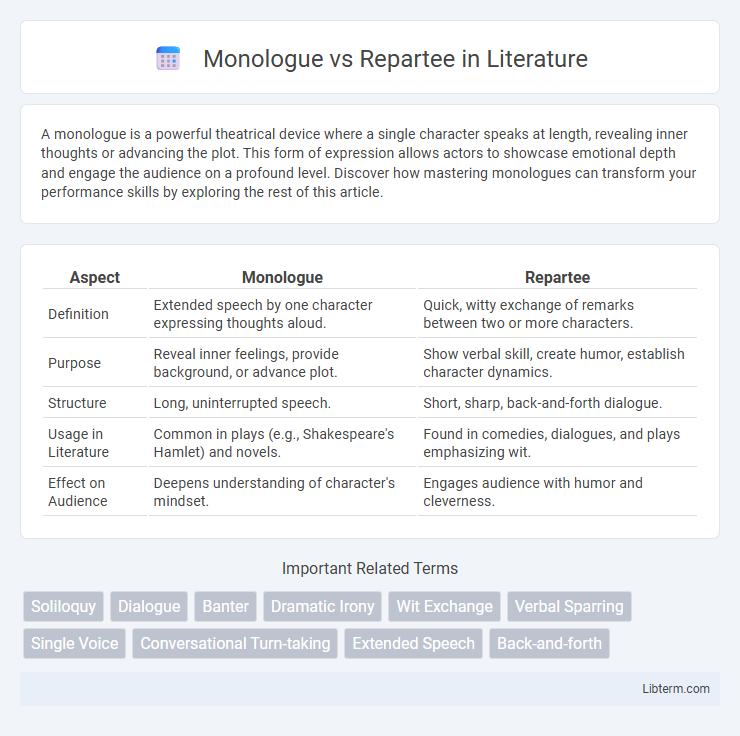A monologue is a powerful theatrical device where a single character speaks at length, revealing inner thoughts or advancing the plot. This form of expression allows actors to showcase emotional depth and engage the audience on a profound level. Discover how mastering monologues can transform your performance skills by exploring the rest of this article.
Table of Comparison
| Aspect | Monologue | Repartee |
|---|---|---|
| Definition | Extended speech by one character expressing thoughts aloud. | Quick, witty exchange of remarks between two or more characters. |
| Purpose | Reveal inner feelings, provide background, or advance plot. | Show verbal skill, create humor, establish character dynamics. |
| Structure | Long, uninterrupted speech. | Short, sharp, back-and-forth dialogue. |
| Usage in Literature | Common in plays (e.g., Shakespeare's Hamlet) and novels. | Found in comedies, dialogues, and plays emphasizing wit. |
| Effect on Audience | Deepens understanding of character's mindset. | Engages audience with humor and cleverness. |
Understanding Monologue and Repartee
Monologue involves a single speaker expressing thoughts or ideas uninterrupted, often revealing character depth and advancing narrative. Repartee is characterized by quick, witty exchanges between two or more individuals, showcasing verbal agility and sharp humor. Understanding the distinction enhances appreciation of dialogue dynamics in literature and performance.
Key Differences Between Monologue and Repartee
Monologue is a long, uninterrupted speech delivered by a single individual, often used to express thoughts or convey detailed information, while repartee is a quick, witty exchange of dialogue between two or more participants, emphasizing sharp, clever responses. Monologues primarily serve a narrative or expressive function in literature and theater, whereas repartee drives dynamic interaction and showcases verbal agility in conversations. The key difference lies in monologue's solitary and extended nature versus repartee's brief, spontaneous, and reciprocal style of communication.
Historical Origins of Monologue and Repartee
Monologues trace back to ancient Greek theater, where solo speeches conveyed characters' inner thoughts and advanced dramatic narratives in tragedies and comedies. Repartee originated in Renaissance courtly conversations and theatrical dialogue, emphasizing quick-witted, sharp exchanges for social and intellectual entertainment. These forms evolved distinctly, with monologues expressing extended personal reflections and repartee showcasing rapid, clever verbal interplay.
The Role of Monologue in Storytelling
Monologues serve as vital narrative tools in storytelling, allowing deep exploration of a character's inner thoughts and emotions without interruption. This uninterrupted speech creates intimacy between the character and audience, revealing motivations and conflicts that drive the plot forward. Unlike repartee, which emphasizes quick, witty exchanges, monologues provide a prolonged, introspective insight essential for character development and thematic depth.
Repartee: The Art of Quick-Witted Dialogue
Repartee is the art of quick-witted dialogue characterized by sharp, intelligent, and spontaneous exchanges that highlight a speaker's mental agility. This form of verbal banter thrives in social interactions, enhancing communication through clever retorts and impactful comebacks. Skilled repartee fosters engagement, humor, and intellectual connection, distinguishing itself from a monologue by its dynamic, reciprocal nature.
Monologue vs Repartee in Drama and Cinema
Monologue and repartee serve distinct dramatic functions in drama and cinema, with monologue providing deep insight into a character's inner thoughts or emotions through extended speech. Repartee, characterized by swift, witty exchanges between characters, advances the plot and reveals interpersonal dynamics with sharp dialogue. Effective use of monologue enriches narrative depth, while repartee enhances pacing and engages the audience through clever verbal interplay.
Impact on Character Development
Monologues provide deep insights into a character's inner thoughts and motivations, revealing complexities and emotional depth that shape audience perception and drive narrative progression. Repartee showcases a character's wit, intelligence, and social dynamics through quick, sharp dialogue exchanges, highlighting relationships and conflicts in real-time. The contrast between monologues and repartee emphasizes internal reflection versus external interaction, both crucial for multi-dimensional character development.
Audience Engagement: Monologue vs Repartee
Repartee drives higher audience engagement through dynamic, quick-witted exchanges that maintain interest and encourage active listening. Monologues rely on a single speaker's ability to captivate, often demanding focused attention but risking listener fatigue without interaction. Effective repartee fosters a participatory atmosphere, making the audience feel involved in the unfolding dialogue.
Famous Examples of Monologue and Repartee
Shakespeare's "Hamlet" features the iconic "To be or not to be" monologue, showcasing introspective reflection and character depth. Oscar Wilde's "The Importance of Being Earnest" is celebrated for its sharp repartee, filled with witty exchanges that highlight social satire. Both forms reveal a character's intellect and personality through distinct verbal styles--monologues offer extended personal insight, while repartee delivers rapid, clever dialogue.
Choosing Between Monologue and Repartee in Creative Writing
Choosing between monologue and repartee in creative writing depends on the desired depth and pace of character interaction. Monologues allow for deep exploration of a character's inner thoughts and motivations, offering rich narrative insight. Repartee, characterized by quick, witty exchanges, enhances dialogue-driven scenes by showcasing character relationships and advancing the plot dynamically.
Monologue Infographic

 libterm.com
libterm.com